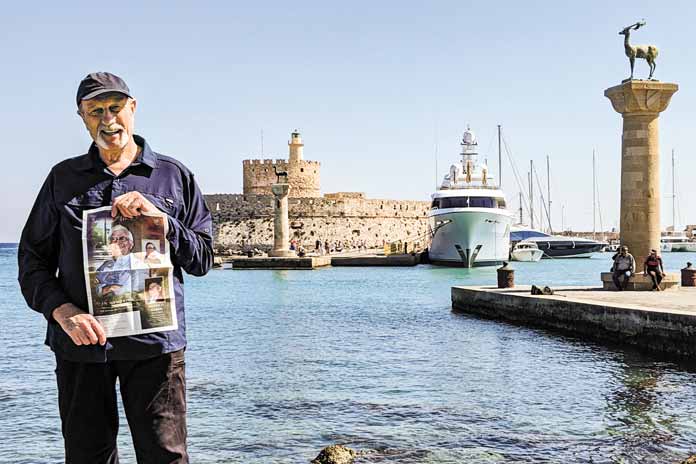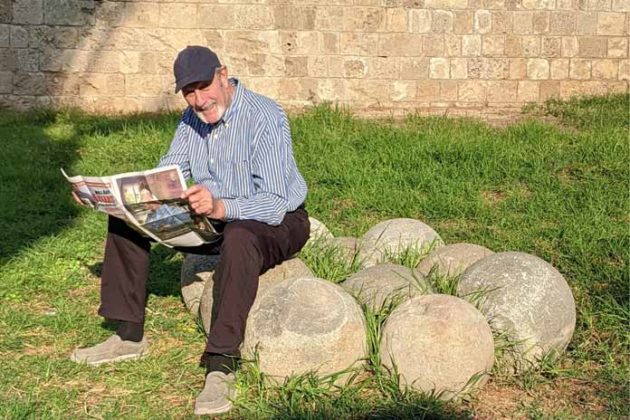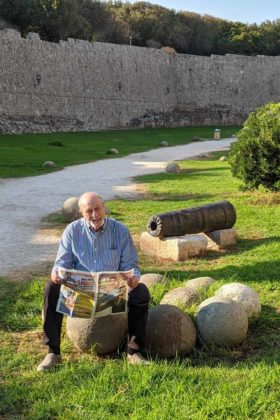 Send in your ALIVE! AROUND THE WORLD
Send in your ALIVE! AROUND THE WORLD
Take Alive! with you wherever you go! Bring your recent copy of Alive! with you when you travel and snap a high resolution photo of you holding Alive!
Send in your pictures and descriptive text using the online form, and we’ll publish it.
SUBMIT YOUR ALIVE! AROUND THE WORLD
Letter From Greece
Rhodes, the Knight’s Island
This late in the year, the weather is still nice, children are back in school, tourists are at their minimum, and best of all most cruise ships are in mothballs. So, what better time could there be to visit the Greek Island of Rhodes?
Many years ago, as a young man and long before I started working for the Port of Los Angeles, my professional boating career started at this medieval port. I worked aboard luxury yachts for the rich and famous around the Mediterranean.

The Old Town of Rhodes has been inhabited for more than 6,000 years, and over the years has been invaded by everyone from Alexander the Great, Greek and Roman democrats, Arabian pirates, failed crusader Knights of St. John and the mighty Ottoman Empire to Benito Mussolini.
In 305 BC, to celebrate the end of one siege, the citizens sold all the defeated army’s weapons and siege equipment to pay sculptor Chares of Lindo to create a giant 31-meter-tall bronze statue of Colossus, whose legs (according to legend) straddled the entrance to the port. (Today there are a couple of symbolic deer on tall columns standing there.) It is more likely to have stood on the high ground where today’s crusaders’ Grande Master Palace now stands.
Regardless of where it stood, an earthquake 66 years later caused it to fall, and the locals felt that it was cursed. Four hundred years later, Arab pirates captured the port and sold the bronze scrap to a Jewish merchant whom they say needed 900 camels to take it away.

During Greek and Roman times, the port prospered, and a temple to the Sun God Helios was built on the foundations where the Colossus of Rhodes once stood. When the Christian Knights of St. John were forced to leave the Holy Land, they occupied the island and extended the fortifications and moat around the port during the 13th to 15th centuries. The moat is a lovely walk from the entrance near the new gate to the end by the cruise terminal. Do wear sensible shoes, as this and the Old Town cobblestone streets can be very hard on in high heels.
Today, Rhodes is considered one of the best-preserved fortified medieval towns in Europe. Behind its six gates are mosques, fountains, Byzantine and Gothic churches, shops and tavernas, plus a warren of some 200 small, cobbled stone alleyways and streets waiting to be explored. Getting lost is a distinct possibility. Visit the Archaeological Museum; walk up the street next to the tourist information office where the Knights of St. John once lived six centuries ago, and visit the imposing Palace of the Grand Master at the top. From 1500 to 1912, the island was under Ottoman Rule, then overtaken by the Italians during World War I. After World War II, in 1947, it finally became part of Greece.
There are many ways to get to Rhodes — by plane, ferry or cruise ship. By air, you can travel from LAX via Frankfurt to Rhodes International Airport. It’s a $35 tax ride or a $2.50 on the public bus to the Old Town. A ferry from the port of Piraeus (Near Athens) will get you there in 16 to 18 hours, or a two-hour high-speed ferry will also get you there from the Turkish port of Marmaris.
If you want to explore the island, you can rent a car. Or for a more relaxed beach vacation, take trips around the island with public buses or taxis.
Tip: Always double-check any bookings or ferry times, as the season of the year does affect departure times
Remember: The world is your oyster; all you must do is open it.

























